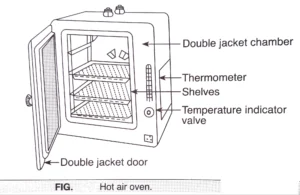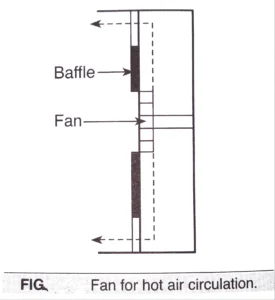Hot air oven is an electrical device used in sterilisation. This instrument was originally developed by Pasteur. The oven uses dry heat to sterilize objects.

Principle of Hot Air Oven
sterilization by dry heat is accomplished by Conduction. The heat is absorbed by the outside surface of the item, layer. The entire item will eventually reach the temperature required for sterilizationto take place.
Dry heat does most of the damage by oxidising molecules. The essential cell constituents are destroyed and organisma dies. The temperature is maintained for almost an hour to kill the most difficult of the resistant spores.
Hot Air oven temperature
The most common time-temperature relationship for sterilization with this laboratory instrument are as follows.
- 170°C for 60 minutes.
- 120⁰ C for 120 minutes.
- 150⁰ C for 150 minutes or longer depending upon the volume.
Diagram and Components of the Instrument

- A hot air oven chamber is made up of aluminium and stainless steel.
- For insulation of the chamber, the outer surface is made using glass fibres.
- The door is also made up of heat insulation substances.
- Also the door has an asbestos lining to ensure the tightly locking and sealing the environment inside the instrument.
- on the outer surface of this instrument it has thermostatically controlled heaters.
- Generally on the backside of the oven a fan is attached for the proper heat circulation by air.

Dry Heat Sterilization uses
- Dry heat sterilization by this method in is used in microbiology labs for sterilizing glasswares such as flasks, beakers, pipettes, test tubes, slides, conicals etc.
- This method is used in sterilization of moisture sensetive materials like paraffin, wool alcohol, dry powders etc.
Read More about Polymerase Chain Reaction : Definition, Steps, Applications
How to Operate Dry Heat Sterilization
- Arrange the material to be sterilised loosely and evenly and then wrapped off the oven, allowing free circulation of air and thereby even heating of the load.
- Air is a poor conductor of heat so the pack should not be loaded tightly.
- Switch on the power supply and control the temperature of the oven by adjusting the thermostat. The time taken by the oven to reach the desired temperature is called “Heating up period”.
- Hold the load in the oven at this temperature for a definite period of time. This period known as “Holding up period” is dependent upon the temperature employed.
- On the expiry of “holding up period” switch off the power supply and allow the load to cool.
- Open the oven door only when temperature falls below 80⁰C, otherwise it may result in breaking up of glasswares and also may cause injuries to the operator.
- Dry the instrument before placing them in the dry heat sterilizing machine.
- Do not place any heat sensitive materials inside this instrument.
Advantages and Disadvantages of Hot Air oven
Advantages
- A dry heat cabinet is easy to install and has relatively low operating costs than other sterilizing instruments.
- It is non toxic, so it doesn’t harm the environment.
- It is non corrosive for metallic and sharp instruments.
Disadvantages
- Time consuming method because of slow rate of heat penetration and microbial killing.
- In addition, high temperatures are not suitable for most of the materials.
- It needs expert operator to handle the sterilizing process.
- Dry heat may not always able to kill some pathogens i.e. Prions.
